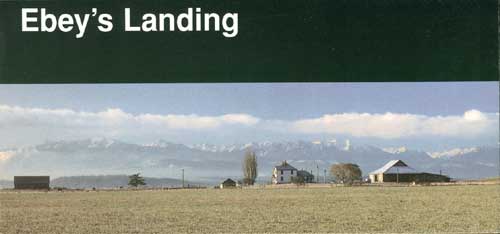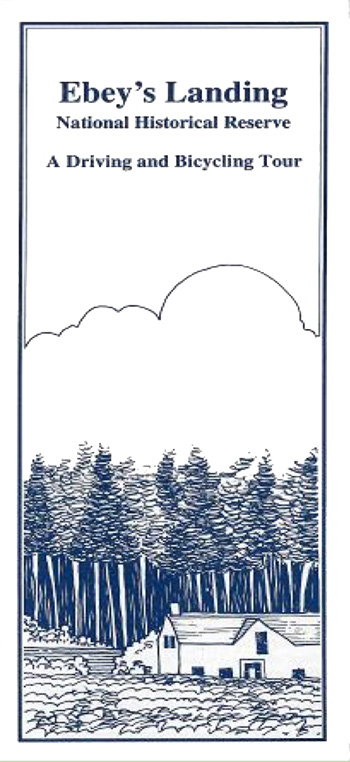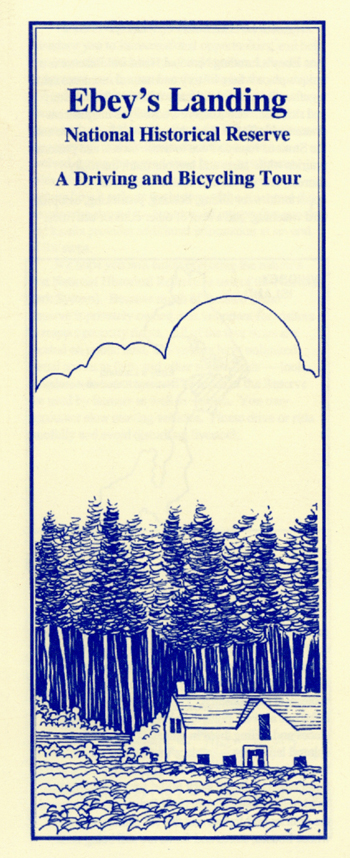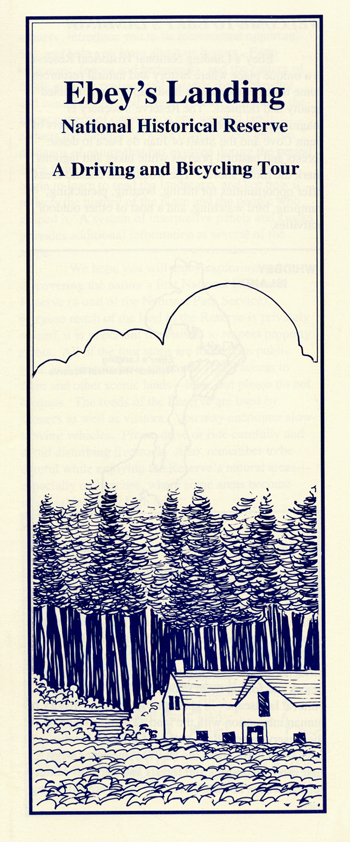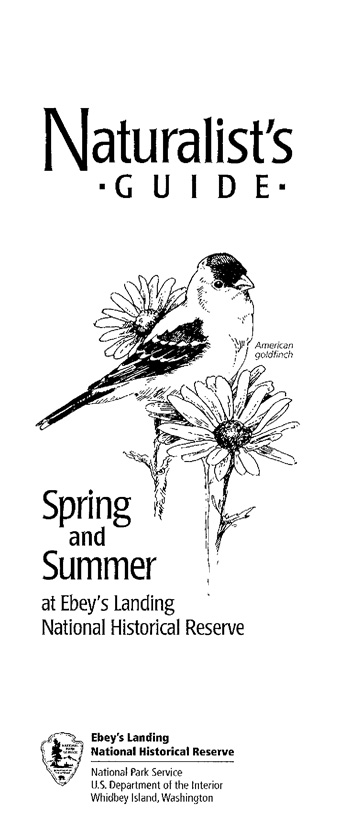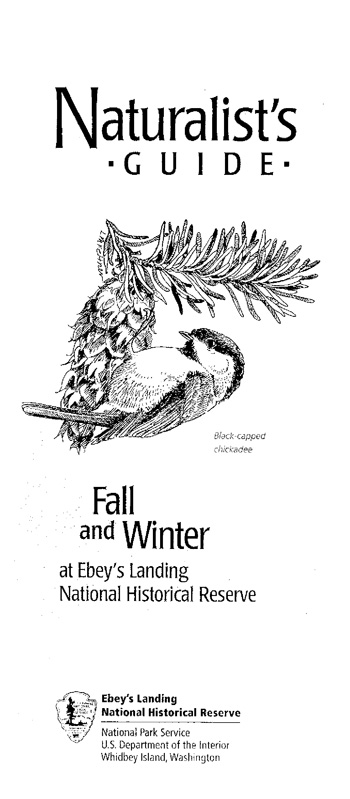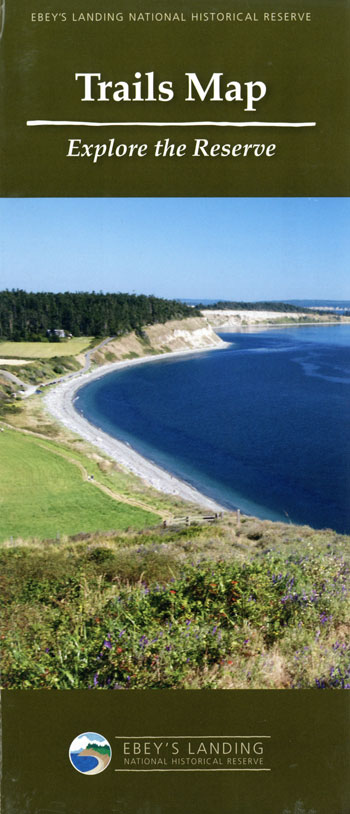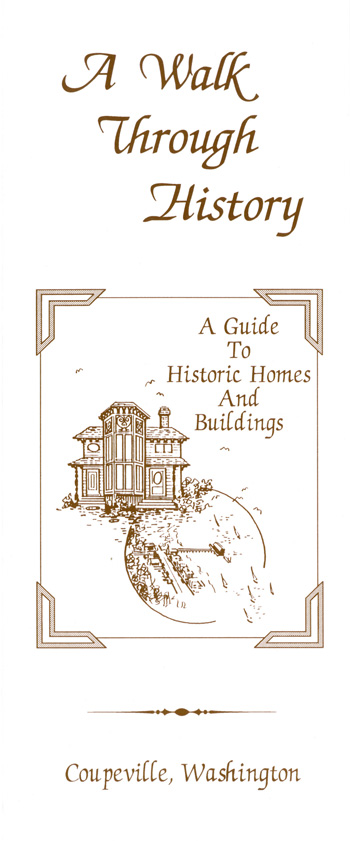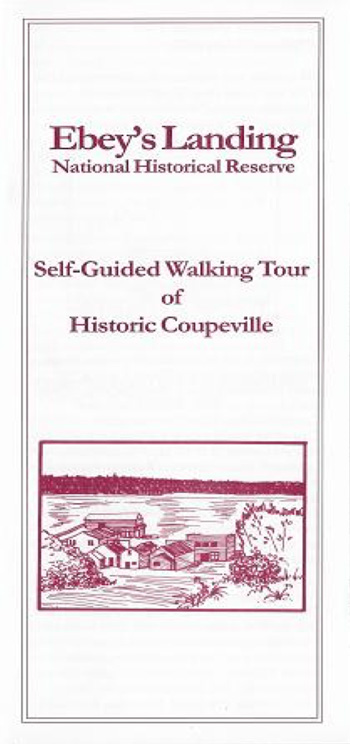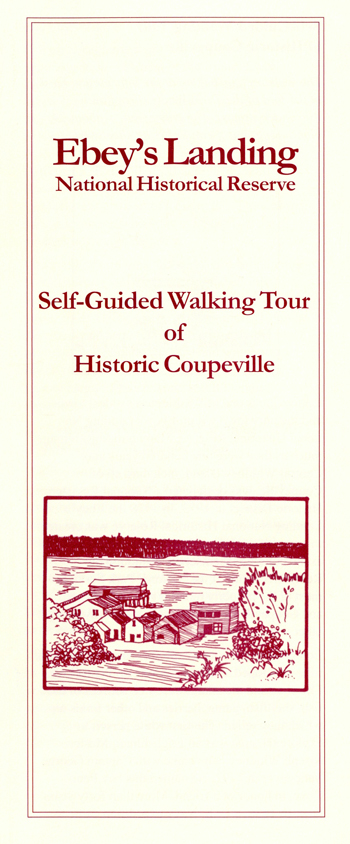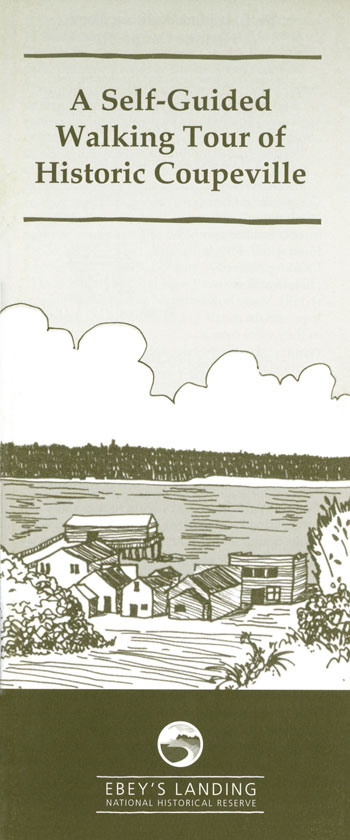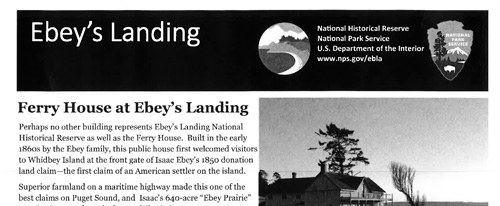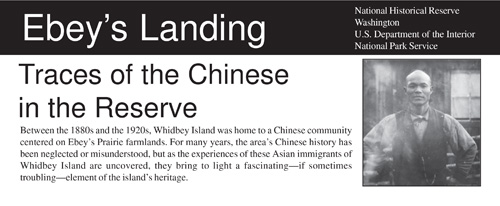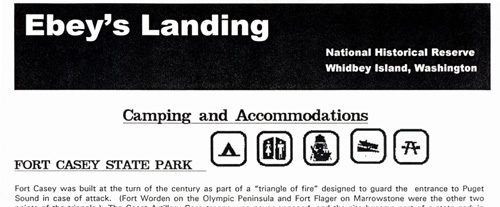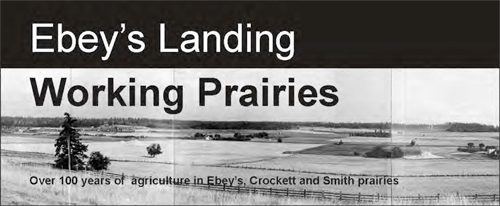|
Ebey's Landing National Historic Reserve Washington |
 |
 NPS photo | |
At Ebey's Landing National Historical Reserve, past meets present in a working rural landscape and community. Established by Congress in 1978, the 17,572-acre Reserve integrates historic farms, a seaside town, native and pioneer land use traditions, and ecologically significant areas.
A Trust Board representing the Town of Coupeville, Island County, Washington State Parks, and the National Park Service manages the Reserve through creative conservation and planned development.
Whether you're a resident or visitor, we invite you to explore this memorable place as we chart the future while honoring the past.
To the north down along Admiralty Inlet ... the cultivating land is generally found confined to the valleys of streams with the exception of Whidbey's Island ... which is almost a paradise of nature. Good land for cultivation is abundant on this island. ... I have taken a claim on it and am now living on the same in order to avail myself of the provisions of the Donation Law. If Rebecca, the children, and you all were here, I think I could live and die here content.
—Col. Isaac Ebey's letter to his brother, 1851
"Almost a Paradise of Nature"
When settlers like the Ebeys came to central Whidbey Island in the 1850s, they met the Skagit people living in shoreline villages. The Skagit had been here for centuries, living on salmon, bottom fish, shellfish, berries, small game, deer, and waterfowl. They cultivated island prairies by selective burning, transplanting, and mulching to encourage the growth of root crops like bracken fern and camas.
Capt. George Vancouver brought Whidbey Island to the attention of Europe and America in 1792. White settlers did not arrive in numbers until the Donation Land Law of 1850. Migrating settlers quickly staked claims while the Lower Skagit people were moved to reservations elsewhere on Puget Sound.
Col. Isaac Neff Ebey was among the first permanent settlers. Ebey and his friend Samuel Crockett came west from Missouri in search of land. Both filed donation claims on central Whidbey by spring 1851. Ebey's family soon followed. The simple home of Isaac's father Jacob and a blockhouse he erected to defend his claim still stand overlooking the prairie that bears the family name. Isaac became a prominent public figure, but his life was cut short in 1857. He was slain by coastal Indians in retaliation for the killing of one of their own tribal members.
Fertile farmland was not the only lure. Sea captains and merchants from New England took advantage of Penn Cove's protected harbor and the stands of tall trees perfect for shipbuilding. One such seafarer was Capt. Thomas Coupe. In 1852 Coupe claimed 320 acres on Penn Cove, which later became the town of Coupeville. He was soon joined by his wife Maria and their children, who arrived by clipper ship via Cape Horn. Central Whidbey's successful farming and maritime trade made Coupeville into a busy seaport.
In the late 1890s the US Army introduced another layer of history on the landscape with the construction of Fort Casey Military Reservation, part of a three-fort defense system protecting the entrance to Puget Sound. Fort Casey became a social center for the community, hosting ball games, dances, and other events. In the western part of the Reserve is the World War II-era Fort Ebey.
Central Whidbey abounds with place names—Coupeville, Crockett Prairie, Lovejoy Point, and Ebey's Landing—that honor people of the past. Their stewardship of the land continues in new ways by new generations.
What is Ebey's Landing National Historical Reserve?
National reserves are areas designated by Congress to preserve, protect, and interpret nationally significant natural, historical, and cultural features. Ebey's Landing, which includes one of Puget Sound's earliest European settlements, became the nation's first national historical reserve because of its long-surviving maritime and land-use traditions.
The Reserve is home-grown. In the 1970s citizens organized to block a housing development at Ebey's Prairie. The effort became a balancing act to preserve the cultural landscape with minimum disturbance to private landowners. In 1978 Ebey's Landing National Historical Reserve was established to "preserve and protect a rural community which provides an unbroken historic record from ... 19th century exploration and settlement in Puget Sound to the present time." Reserves differ from other conservation areas in their approach to preservation and management. Ebey's Landing is administered through a collaboration of the National Park Service, Washington State Parks, Island County, and the town of Coupeville.
Congress intended Reserve lands to remain largely under private ownership, although there are also federal, state, and county lands within the boundary. Techniques used to preserve open space, farmland, and historic sites include land donations, tax incentives, zoning, local design review, and voluntary transfers of development rights.
You have an important role in the success of this innovative mission. As you explore, use designated trails and public access areas. Please respect private property, and do not enter farmers' fields, drive on roads marked "private," or park on private property.
The vistas, woodlands, and prairies of the Reserve are much the same today as they were in the 1800s when New England sea captains came to Penn Cove and farmers to the land. Yet the Reserve is far more than a snapshot in time. It is a working, changing community.
Bluffs, Blockhouses, Island Prairies, and More
Things to See and Do
 (click for larger map) |
Ebey's Landing National Historical Reserve is a living rural community. It does not have general operating hours or admission fees. It is always open and you can visit year-round.
Places of interest within the Reserve are independently operated. Hours vary depending on the season, and some sites charge a fee.
TOWN OF COUPEVILLE
At the heart of the Reserve is the well-preserved seaport town of Coupeville,
just off WA SR 20. To see the colorful Victorian architecture, take the
self-guiding walking tour.
Explore the shops and eateries along Front Street. Stroll out on the wharf, a reminder that travel and trade were mostly by water in the 1800s. Visit the farmers market April through November.
Stop at the Island County Historical Museum to learn about Coupeville, the Reserve, and Island County. Open seven days a week, year-round. For a listing of events in Central Whidbey, visit www.coupevillechamber.com.
TRAILS
The Bluff Trail overlooking Ebey's Landing has the most wide-ranging views in
the Reserve: Mt. Baker, Strait of Juan de Fuca, Olympic Mountains, Mount
Rainier, and historic farmland and prairie.
Trailheads are found at Ebey's Landing State Park and at the Prairie Overlook near Sunnyside Cemetery. An extensive trail system, popular with cyclists and walkers, is accessed at the Kettles Trail area off WA SR 20 and at Fort Ebey State Park.
WORKING FARMS
Many 1800s and 1900s farmsteads are still working farms. Roads, fences, and
hedgerows often follow the boundaries of these original land claims. Early
settlers' diaries describe abundant crops, some of which are still grown
here.
WASHINGTON STATE PARKS
There are three state parks within the Reserve boundary: Fort Ebey, Ebey's
Landing, and Fort Casey. The forts once protected the entrance to Puget Sound
and its shipyards. You can explore their historic gun emplacements, as well as
the Admiralty Head Lighthouse at Fort Casey.
FOR A SAFE VISIT
Beach fires are not permitted. • High tides can be hazardous to beach
hikers. Use extreme caution to avoid being trapped on headlands, and watch
carefully for beach logs moved by sudden high waves. • Please avoid
stopping your vehicle in the middle of narrow roads or private driveways.
GOOD STEWARDSHIP BEGINS WITH YOU
Most of the Reserve is private property. Please respect the property rights of
the residents of historic homes and farmsteads, and remember to hike only on
designated trails.
Dogs must be kept on a leash at all times. Please leave driftwood, plants, rocks, and other natural features within the Reserve undisturbed for others to enjoy.
MORE INFORMATION
For information about lodging and other services, contact Coupeville Chamber of
Commerce, www.coupevillechamber.com.
Camping within the Reserve is limited to Fort Casey and Fort Ebey state parks (www.parks.wa.gov) and Rhododendron Park (www.islandcountywa.gov).
Discover more about the partnership that is Ebey's Landing National Historical Reserve by visiting www.nps.gov/ebla.
Getting to the Reserve
Ebey's Landing National Historical Reserve is on Whidbey Island in Puget Sound. The island is easily accessible from the mainland by vehicle via WA SR 20 from Burlington. The Washington State Ferry system provides year-round foot passenger, bicycle, and vehicle service to the island from Mukilteo and Port Townsend. In the summer season, ferry lines can be quite long, and travel delays should be expected. Caution: The Port Townsend ferry may be cancelled due to tide or weather conditions. For the ferry schedule, visit www.wsdot.wa.gov/ferries.
Source: NPS Brochure (2019)
|
Establishment
Central Whidbey Island Historic District — 1973 |
For More Information Please Visit The  OFFICIAL NPS WEBSITE |
Brochures ◆ Site Bulletins ◆ Trading Cards

Documents
Acoustic Monitoring Report, Ebey's Landing National Historical Reserve NPS Natural Resource Report NRR-2016/1299 (Ashley Pipkin, November 2016)
An Unbroken Historical Records: Ebey's Landing National Historical Reserve, Administrative History (HTML edition) (Laura McKinley, 1993)
Assessment of Coastal Water Resources and Watershed Conditions at Ebey's Landing Historical Reserve (Washington) NPS Natural Resource Technical Report NPS/NRWRD/NRTR-2007/369 (Terrie Klinger, David Fluharty, Carrie Byron, Kirsten Evans and Jill Coyle, May 2007)
Beyond Isaac Ebey: Tracing the Remnants of Native American Culture on Whidbey Island (Theresa Trebon, extract from Columbia: The Magazine of Northwest History, Vol. 14 No. 3, Fall 2000; ©Washington State Historical Society)
Draft General Management Plan and Environmental Impact Statement, Ebey's Landing National Historical Reserve: Volume I (September 2005)
Draft General Management Plan and Environmental Impact Statement, Ebey's Landing National Historical Reserve: Volume II (September 2005)
Exploring 10,000 Years of Human History on Ebey's Prairie, Whidbey Island, Washington (Andrea L. Weiser, Fall 2006)
Foundation Document, Ebey's Landing National Historical Reserve, Washington (November 2018)
Geologic Resources Inventory Report, Ebey's Landing National Historical Reserve NPS Natural Resource Report NPS/NRPC/GRD/NRR-2011/451 (J. Graham, September 2011)
Historic Resources Study: Ebey's Landing National Historical Reserve (Gail E.H. Evans-Hatch and Michael Evans-Hatch, 1995)
Intertidal Fish Inventory of Ebey's Landing National Historical Reserve (2005) NPS Natural Resource Technical Report NPS/NCCN/NRTR-2011/453 (Steven C. Fradkin, May 2011)
Ebey's Landing National Historical Reserve Junior Ranger & Activity Book (Date Unknown; for reference purposes only)
Junior Ranger Activity Book, Ebey's Landing National Historical Reserve (2017; for reference purposes only)
Museum Management Plan: North Cascades National Park Service Complex, Ebey's Landing National Historical Preserve (Jonathan Bayless, Robert Applegate, Kelly Cahill, Kirstie Haertel and Diane Nicholson, 2005)
National Register of Historic Places Nomination Form
Central Whidbey Island Historic District (Jimmie Jean Cook, May 1, 1972)
North Coast and Cascades Network Climate Monitoring Report: Ebey’s Landing National Historical Reserve and San Juan Island National Historical Park; Water Year 2010 NPS Natural Resource Data Series NPS/NCCN/NRDS—2012/327 (William Baccus and Mark Huff, June 2012)
North Coast and Cascades Network Climate Monitoring Report: Ebey’s Landing National Historical Reserve and San Juan Island National Historical Park; Water Year 2011 NPS Natural Resource Data Series NPS/NCCN/NRDS—2013/569 (William Baccus and Mark Huff, October 2013)
Park Newspaper: 2015
Plant Associations Known or With Potential to Occur within Ebey's Landing National Historic Reserve, Fort Vancouver National Historic Site, Lewis and Clark National Historic Park, San Juan National Historic Park (F. Joseph Rocchio and Rex C. Crawford, March 2009)
Reading the Cultural Landscape, Ebey's Landing National Historical Reserve (HTML edition) (Cathy A. Gilbert, Spring 1985)
The Garden and the Wilderness (Date Unknown)
The Land, The People, The Place: An Introduction to the Inventory, Ebey's Landing National Historical Reserve (Cathy Gilbert w/Gretchen Luxenberg and T. Allan Comp, Winter 1984)
Vascular Plant Inventory of Ebey's Landing National Historical Reserve NPS Natural Resource Technical Report NPS/NCCN/NRTR-2010/346 (Regina M. Rochefort, June 2010)
Ebey's Landing National Historical Reserve
Books

ebla/index.htm
Last Updated: 11-Sep-2024


